Masters of Nursing Project: Patient Safety, Communication, Outcomes
VerifiedAdded on 2023/01/05
|10
|3272
|78
Essay
AI Summary
This Masters of Nursing project essay critically examines patient safety within healthcare settings, emphasizing the principle that 'no one should be harmed while receiving healthcare.' It delves into the importance of patient-centered care, analyzing both positive and negative health outcomes, and exploring contributing factors such as clinical communication and interprofessional collaboration. The essay provides a detailed case study of a student nurse's experience, highlighting communication breakdowns and medication errors. It discusses various communication models and their application in healthcare, as well as the impact of leadership and a positive patient safety culture. The essay concludes with recommendations for enhancing patient safety through improved training, staffing levels, and error reporting systems, ultimately aiming to foster a healthcare environment where patients feel safe and receive optimal care.
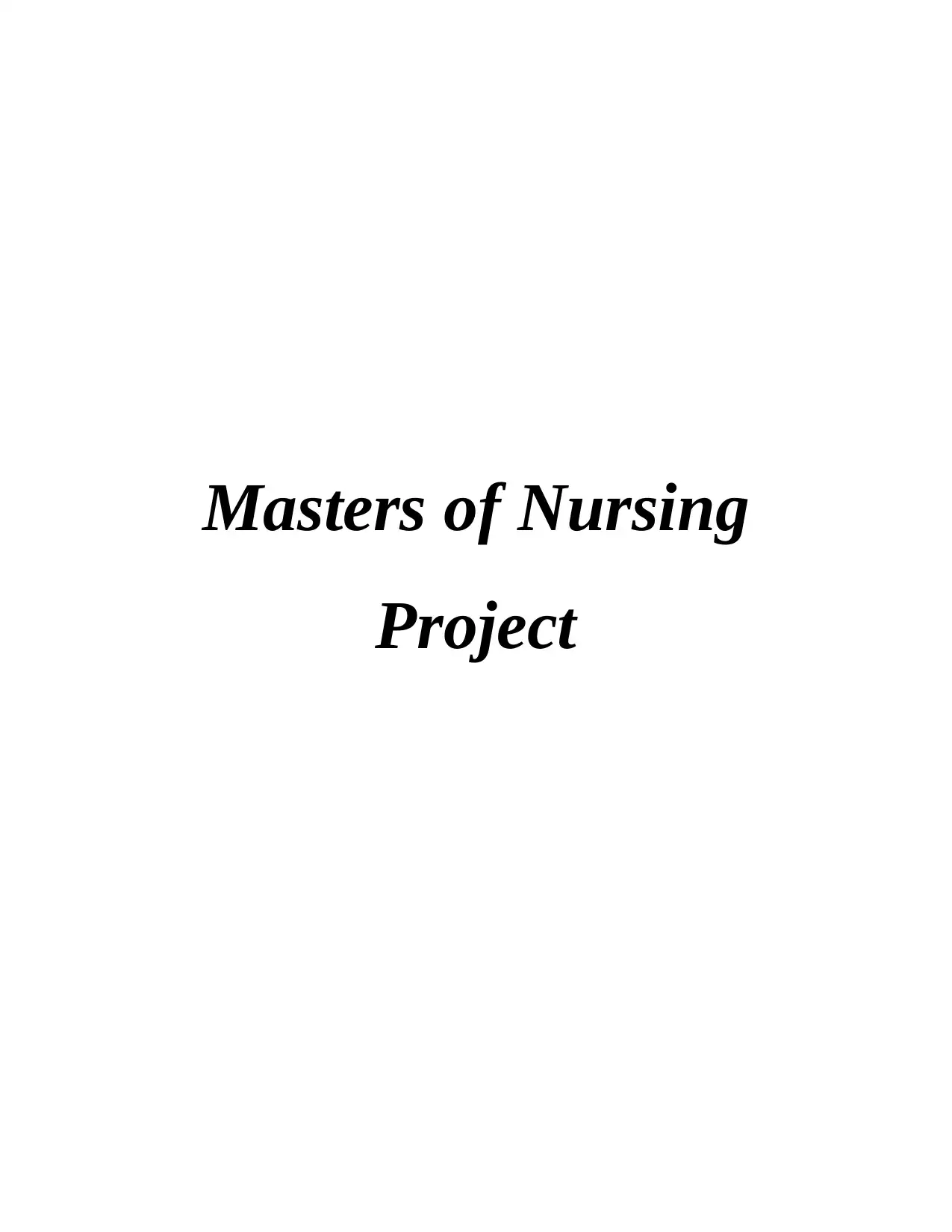
Masters of Nursing
Project
Project
Paraphrase This Document
Need a fresh take? Get an instant paraphrase of this document with our AI Paraphraser
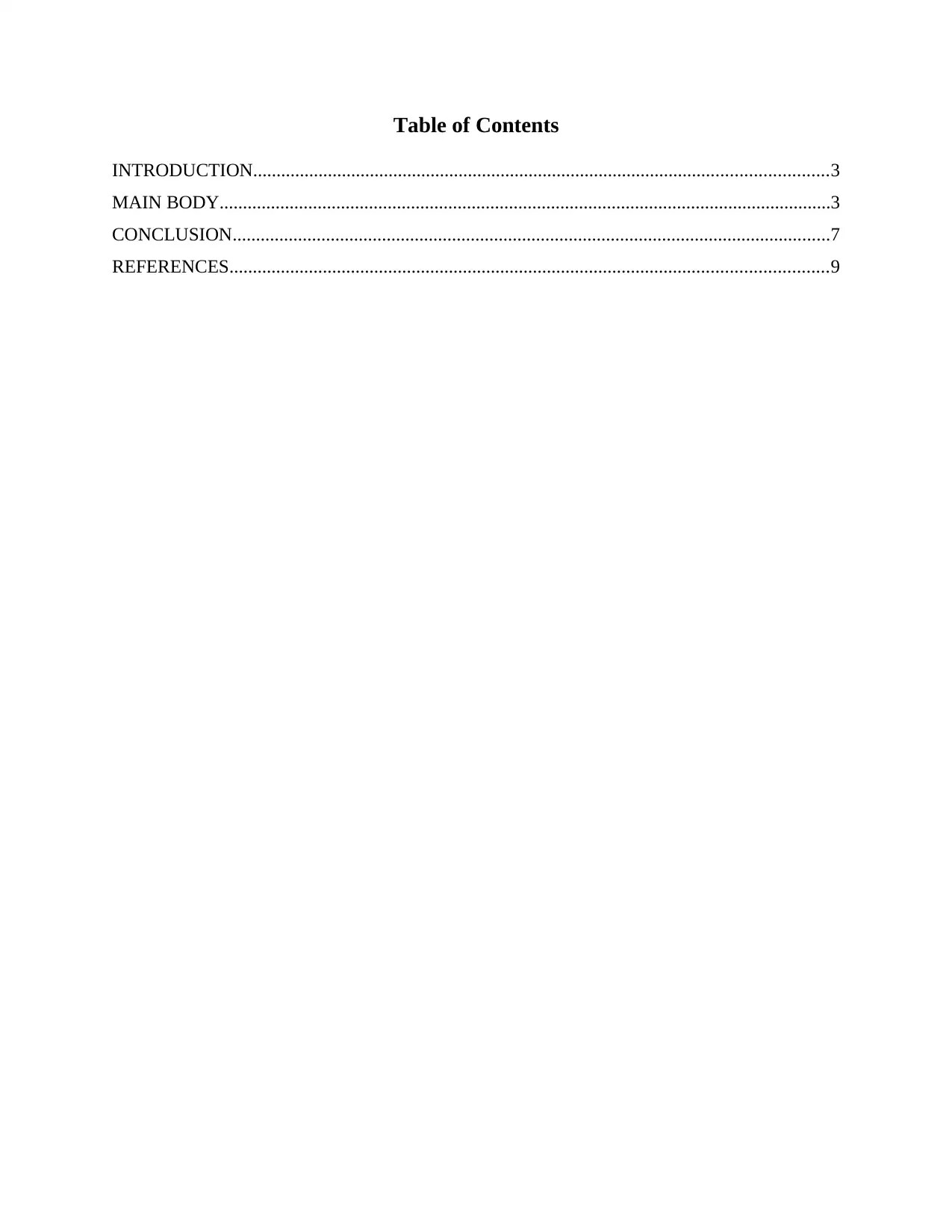
Table of Contents
INTRODUCTION...........................................................................................................................3
MAIN BODY...................................................................................................................................3
CONCLUSION................................................................................................................................7
REFERENCES................................................................................................................................9
INTRODUCTION...........................................................................................................................3
MAIN BODY...................................................................................................................................3
CONCLUSION................................................................................................................................7
REFERENCES................................................................................................................................9
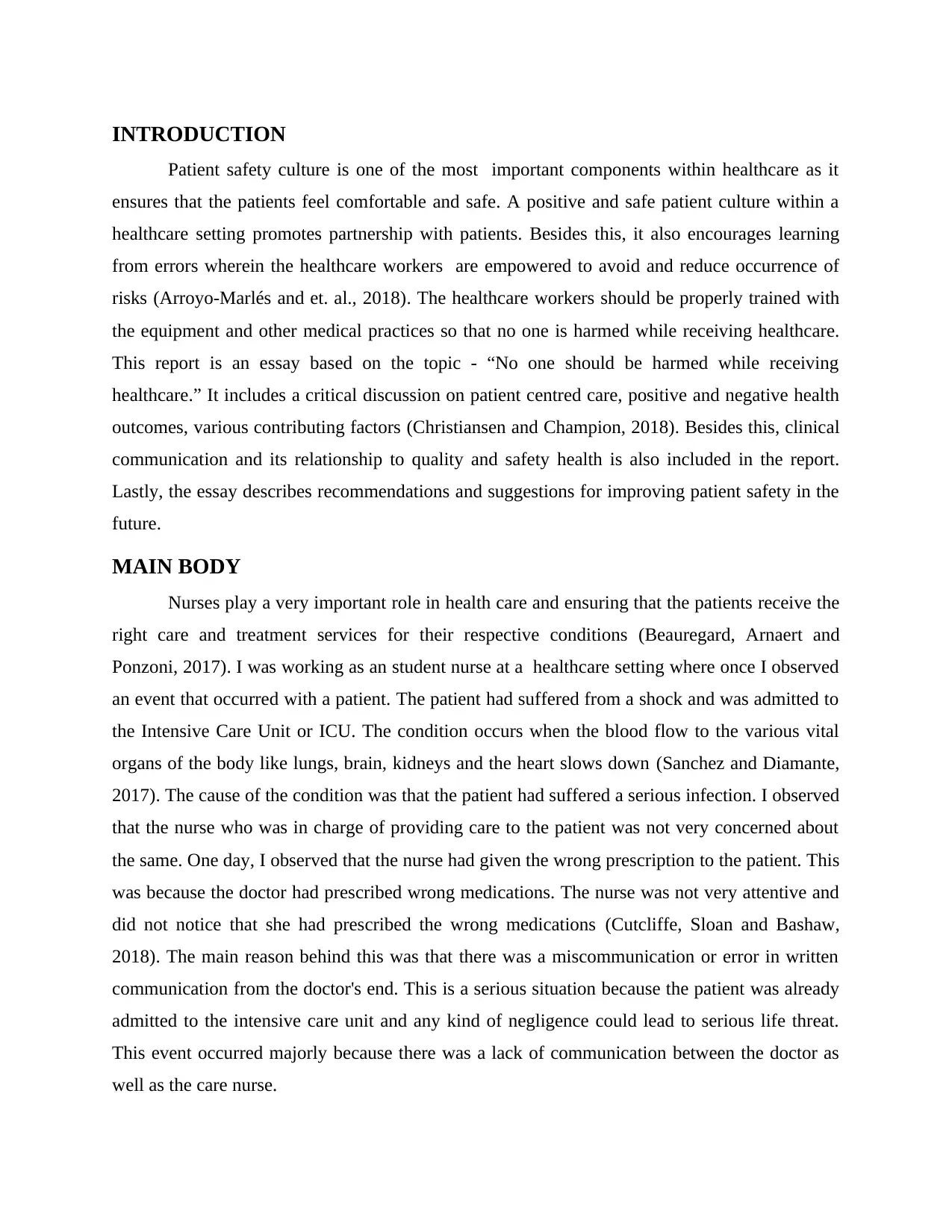
INTRODUCTION
Patient safety culture is one of the most important components within healthcare as it
ensures that the patients feel comfortable and safe. A positive and safe patient culture within a
healthcare setting promotes partnership with patients. Besides this, it also encourages learning
from errors wherein the healthcare workers are empowered to avoid and reduce occurrence of
risks (Arroyo‐Marlés and et. al., 2018). The healthcare workers should be properly trained with
the equipment and other medical practices so that no one is harmed while receiving healthcare.
This report is an essay based on the topic - “No one should be harmed while receiving
healthcare.” It includes a critical discussion on patient centred care, positive and negative health
outcomes, various contributing factors (Christiansen and Champion, 2018). Besides this, clinical
communication and its relationship to quality and safety health is also included in the report.
Lastly, the essay describes recommendations and suggestions for improving patient safety in the
future.
MAIN BODY
Nurses play a very important role in health care and ensuring that the patients receive the
right care and treatment services for their respective conditions (Beauregard, Arnaert and
Ponzoni, 2017). I was working as an student nurse at a healthcare setting where once I observed
an event that occurred with a patient. The patient had suffered from a shock and was admitted to
the Intensive Care Unit or ICU. The condition occurs when the blood flow to the various vital
organs of the body like lungs, brain, kidneys and the heart slows down (Sanchez and Diamante,
2017). The cause of the condition was that the patient had suffered a serious infection. I observed
that the nurse who was in charge of providing care to the patient was not very concerned about
the same. One day, I observed that the nurse had given the wrong prescription to the patient. This
was because the doctor had prescribed wrong medications. The nurse was not very attentive and
did not notice that she had prescribed the wrong medications (Cutcliffe, Sloan and Bashaw,
2018). The main reason behind this was that there was a miscommunication or error in written
communication from the doctor's end. This is a serious situation because the patient was already
admitted to the intensive care unit and any kind of negligence could lead to serious life threat.
This event occurred majorly because there was a lack of communication between the doctor as
well as the care nurse.
Patient safety culture is one of the most important components within healthcare as it
ensures that the patients feel comfortable and safe. A positive and safe patient culture within a
healthcare setting promotes partnership with patients. Besides this, it also encourages learning
from errors wherein the healthcare workers are empowered to avoid and reduce occurrence of
risks (Arroyo‐Marlés and et. al., 2018). The healthcare workers should be properly trained with
the equipment and other medical practices so that no one is harmed while receiving healthcare.
This report is an essay based on the topic - “No one should be harmed while receiving
healthcare.” It includes a critical discussion on patient centred care, positive and negative health
outcomes, various contributing factors (Christiansen and Champion, 2018). Besides this, clinical
communication and its relationship to quality and safety health is also included in the report.
Lastly, the essay describes recommendations and suggestions for improving patient safety in the
future.
MAIN BODY
Nurses play a very important role in health care and ensuring that the patients receive the
right care and treatment services for their respective conditions (Beauregard, Arnaert and
Ponzoni, 2017). I was working as an student nurse at a healthcare setting where once I observed
an event that occurred with a patient. The patient had suffered from a shock and was admitted to
the Intensive Care Unit or ICU. The condition occurs when the blood flow to the various vital
organs of the body like lungs, brain, kidneys and the heart slows down (Sanchez and Diamante,
2017). The cause of the condition was that the patient had suffered a serious infection. I observed
that the nurse who was in charge of providing care to the patient was not very concerned about
the same. One day, I observed that the nurse had given the wrong prescription to the patient. This
was because the doctor had prescribed wrong medications. The nurse was not very attentive and
did not notice that she had prescribed the wrong medications (Cutcliffe, Sloan and Bashaw,
2018). The main reason behind this was that there was a miscommunication or error in written
communication from the doctor's end. This is a serious situation because the patient was already
admitted to the intensive care unit and any kind of negligence could lead to serious life threat.
This event occurred majorly because there was a lack of communication between the doctor as
well as the care nurse.
⊘ This is a preview!⊘
Do you want full access?
Subscribe today to unlock all pages.

Trusted by 1+ million students worldwide
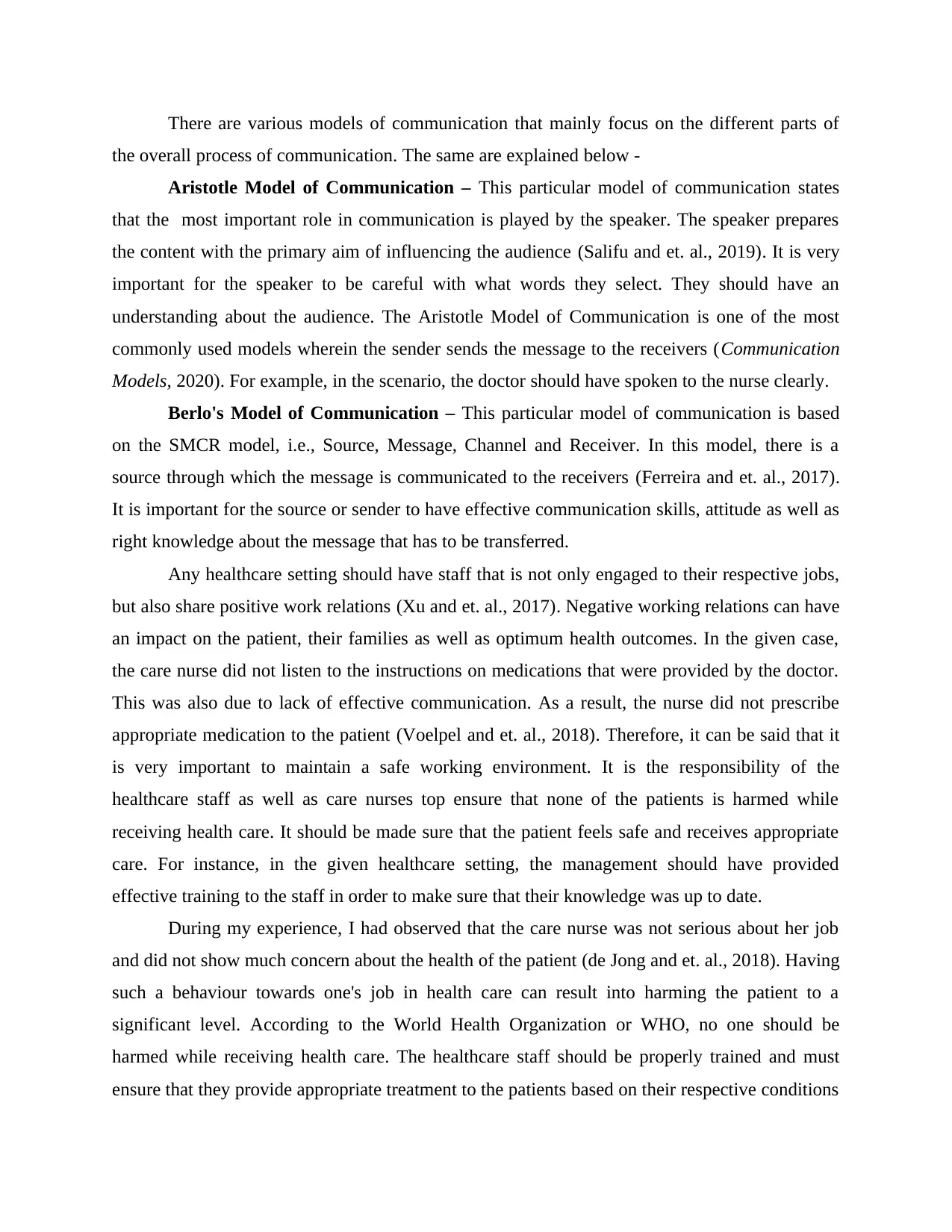
There are various models of communication that mainly focus on the different parts of
the overall process of communication. The same are explained below -
Aristotle Model of Communication – This particular model of communication states
that the most important role in communication is played by the speaker. The speaker prepares
the content with the primary aim of influencing the audience (Salifu and et. al., 2019). It is very
important for the speaker to be careful with what words they select. They should have an
understanding about the audience. The Aristotle Model of Communication is one of the most
commonly used models wherein the sender sends the message to the receivers (Communication
Models, 2020). For example, in the scenario, the doctor should have spoken to the nurse clearly.
Berlo's Model of Communication – This particular model of communication is based
on the SMCR model, i.e., Source, Message, Channel and Receiver. In this model, there is a
source through which the message is communicated to the receivers (Ferreira and et. al., 2017).
It is important for the source or sender to have effective communication skills, attitude as well as
right knowledge about the message that has to be transferred.
Any healthcare setting should have staff that is not only engaged to their respective jobs,
but also share positive work relations (Xu and et. al., 2017). Negative working relations can have
an impact on the patient, their families as well as optimum health outcomes. In the given case,
the care nurse did not listen to the instructions on medications that were provided by the doctor.
This was also due to lack of effective communication. As a result, the nurse did not prescribe
appropriate medication to the patient (Voelpel and et. al., 2018). Therefore, it can be said that it
is very important to maintain a safe working environment. It is the responsibility of the
healthcare staff as well as care nurses top ensure that none of the patients is harmed while
receiving health care. It should be made sure that the patient feels safe and receives appropriate
care. For instance, in the given healthcare setting, the management should have provided
effective training to the staff in order to make sure that their knowledge was up to date.
During my experience, I had observed that the care nurse was not serious about her job
and did not show much concern about the health of the patient (de Jong and et. al., 2018). Having
such a behaviour towards one's job in health care can result into harming the patient to a
significant level. According to the World Health Organization or WHO, no one should be
harmed while receiving health care. The healthcare staff should be properly trained and must
ensure that they provide appropriate treatment to the patients based on their respective conditions
the overall process of communication. The same are explained below -
Aristotle Model of Communication – This particular model of communication states
that the most important role in communication is played by the speaker. The speaker prepares
the content with the primary aim of influencing the audience (Salifu and et. al., 2019). It is very
important for the speaker to be careful with what words they select. They should have an
understanding about the audience. The Aristotle Model of Communication is one of the most
commonly used models wherein the sender sends the message to the receivers (Communication
Models, 2020). For example, in the scenario, the doctor should have spoken to the nurse clearly.
Berlo's Model of Communication – This particular model of communication is based
on the SMCR model, i.e., Source, Message, Channel and Receiver. In this model, there is a
source through which the message is communicated to the receivers (Ferreira and et. al., 2017).
It is important for the source or sender to have effective communication skills, attitude as well as
right knowledge about the message that has to be transferred.
Any healthcare setting should have staff that is not only engaged to their respective jobs,
but also share positive work relations (Xu and et. al., 2017). Negative working relations can have
an impact on the patient, their families as well as optimum health outcomes. In the given case,
the care nurse did not listen to the instructions on medications that were provided by the doctor.
This was also due to lack of effective communication. As a result, the nurse did not prescribe
appropriate medication to the patient (Voelpel and et. al., 2018). Therefore, it can be said that it
is very important to maintain a safe working environment. It is the responsibility of the
healthcare staff as well as care nurses top ensure that none of the patients is harmed while
receiving health care. It should be made sure that the patient feels safe and receives appropriate
care. For instance, in the given healthcare setting, the management should have provided
effective training to the staff in order to make sure that their knowledge was up to date.
During my experience, I had observed that the care nurse was not serious about her job
and did not show much concern about the health of the patient (de Jong and et. al., 2018). Having
such a behaviour towards one's job in health care can result into harming the patient to a
significant level. According to the World Health Organization or WHO, no one should be
harmed while receiving health care. The healthcare staff should be properly trained and must
ensure that they provide appropriate treatment to the patients based on their respective conditions
Paraphrase This Document
Need a fresh take? Get an instant paraphrase of this document with our AI Paraphraser
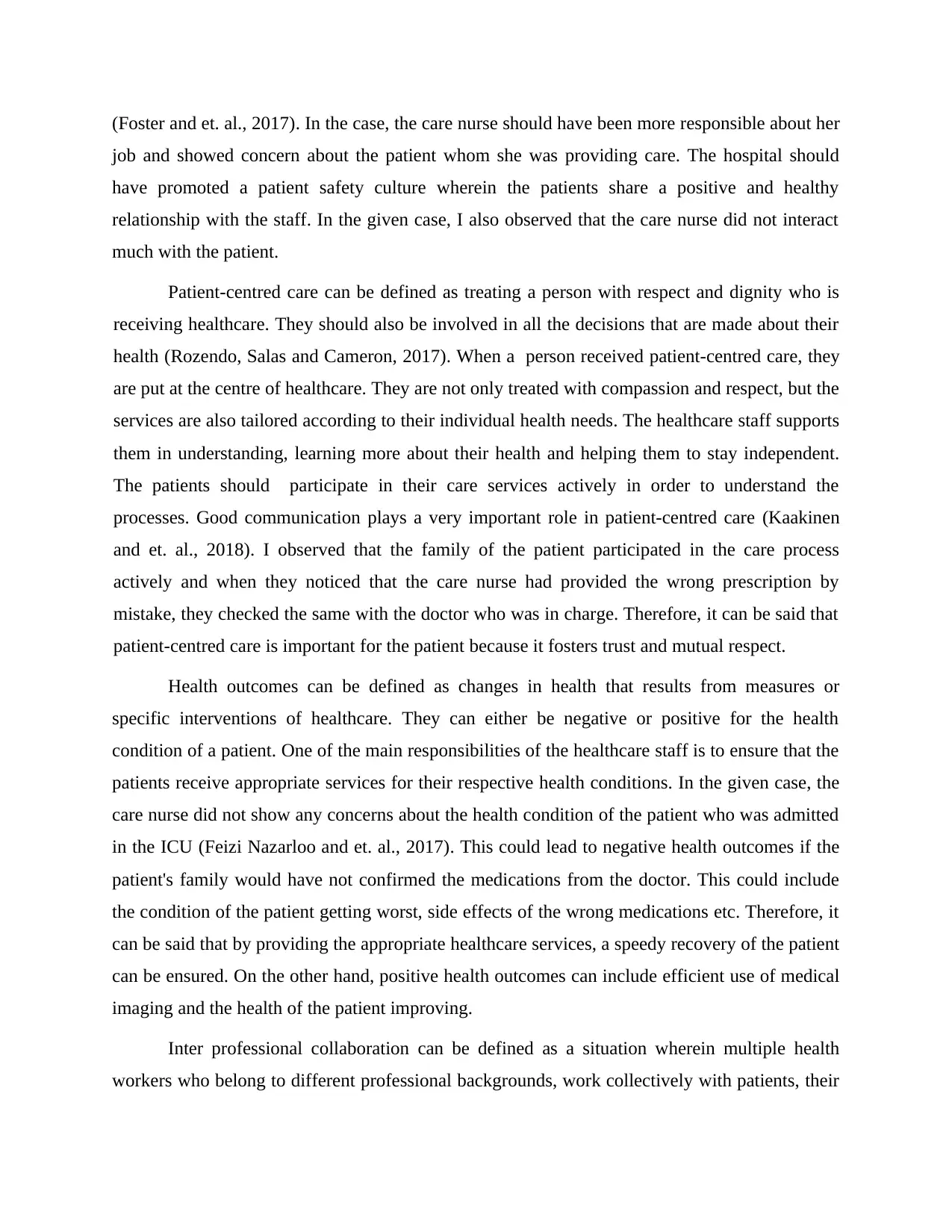
(Foster and et. al., 2017). In the case, the care nurse should have been more responsible about her
job and showed concern about the patient whom she was providing care. The hospital should
have promoted a patient safety culture wherein the patients share a positive and healthy
relationship with the staff. In the given case, I also observed that the care nurse did not interact
much with the patient.
Patient-centred care can be defined as treating a person with respect and dignity who is
receiving healthcare. They should also be involved in all the decisions that are made about their
health (Rozendo, Salas and Cameron, 2017). When a person received patient-centred care, they
are put at the centre of healthcare. They are not only treated with compassion and respect, but the
services are also tailored according to their individual health needs. The healthcare staff supports
them in understanding, learning more about their health and helping them to stay independent.
The patients should participate in their care services actively in order to understand the
processes. Good communication plays a very important role in patient-centred care (Kaakinen
and et. al., 2018). I observed that the family of the patient participated in the care process
actively and when they noticed that the care nurse had provided the wrong prescription by
mistake, they checked the same with the doctor who was in charge. Therefore, it can be said that
patient-centred care is important for the patient because it fosters trust and mutual respect.
Health outcomes can be defined as changes in health that results from measures or
specific interventions of healthcare. They can either be negative or positive for the health
condition of a patient. One of the main responsibilities of the healthcare staff is to ensure that the
patients receive appropriate services for their respective health conditions. In the given case, the
care nurse did not show any concerns about the health condition of the patient who was admitted
in the ICU (Feizi Nazarloo and et. al., 2017). This could lead to negative health outcomes if the
patient's family would have not confirmed the medications from the doctor. This could include
the condition of the patient getting worst, side effects of the wrong medications etc. Therefore, it
can be said that by providing the appropriate healthcare services, a speedy recovery of the patient
can be ensured. On the other hand, positive health outcomes can include efficient use of medical
imaging and the health of the patient improving.
Inter professional collaboration can be defined as a situation wherein multiple health
workers who belong to different professional backgrounds, work collectively with patients, their
job and showed concern about the patient whom she was providing care. The hospital should
have promoted a patient safety culture wherein the patients share a positive and healthy
relationship with the staff. In the given case, I also observed that the care nurse did not interact
much with the patient.
Patient-centred care can be defined as treating a person with respect and dignity who is
receiving healthcare. They should also be involved in all the decisions that are made about their
health (Rozendo, Salas and Cameron, 2017). When a person received patient-centred care, they
are put at the centre of healthcare. They are not only treated with compassion and respect, but the
services are also tailored according to their individual health needs. The healthcare staff supports
them in understanding, learning more about their health and helping them to stay independent.
The patients should participate in their care services actively in order to understand the
processes. Good communication plays a very important role in patient-centred care (Kaakinen
and et. al., 2018). I observed that the family of the patient participated in the care process
actively and when they noticed that the care nurse had provided the wrong prescription by
mistake, they checked the same with the doctor who was in charge. Therefore, it can be said that
patient-centred care is important for the patient because it fosters trust and mutual respect.
Health outcomes can be defined as changes in health that results from measures or
specific interventions of healthcare. They can either be negative or positive for the health
condition of a patient. One of the main responsibilities of the healthcare staff is to ensure that the
patients receive appropriate services for their respective health conditions. In the given case, the
care nurse did not show any concerns about the health condition of the patient who was admitted
in the ICU (Feizi Nazarloo and et. al., 2017). This could lead to negative health outcomes if the
patient's family would have not confirmed the medications from the doctor. This could include
the condition of the patient getting worst, side effects of the wrong medications etc. Therefore, it
can be said that by providing the appropriate healthcare services, a speedy recovery of the patient
can be ensured. On the other hand, positive health outcomes can include efficient use of medical
imaging and the health of the patient improving.
Inter professional collaboration can be defined as a situation wherein multiple health
workers who belong to different professional backgrounds, work collectively with patients, their
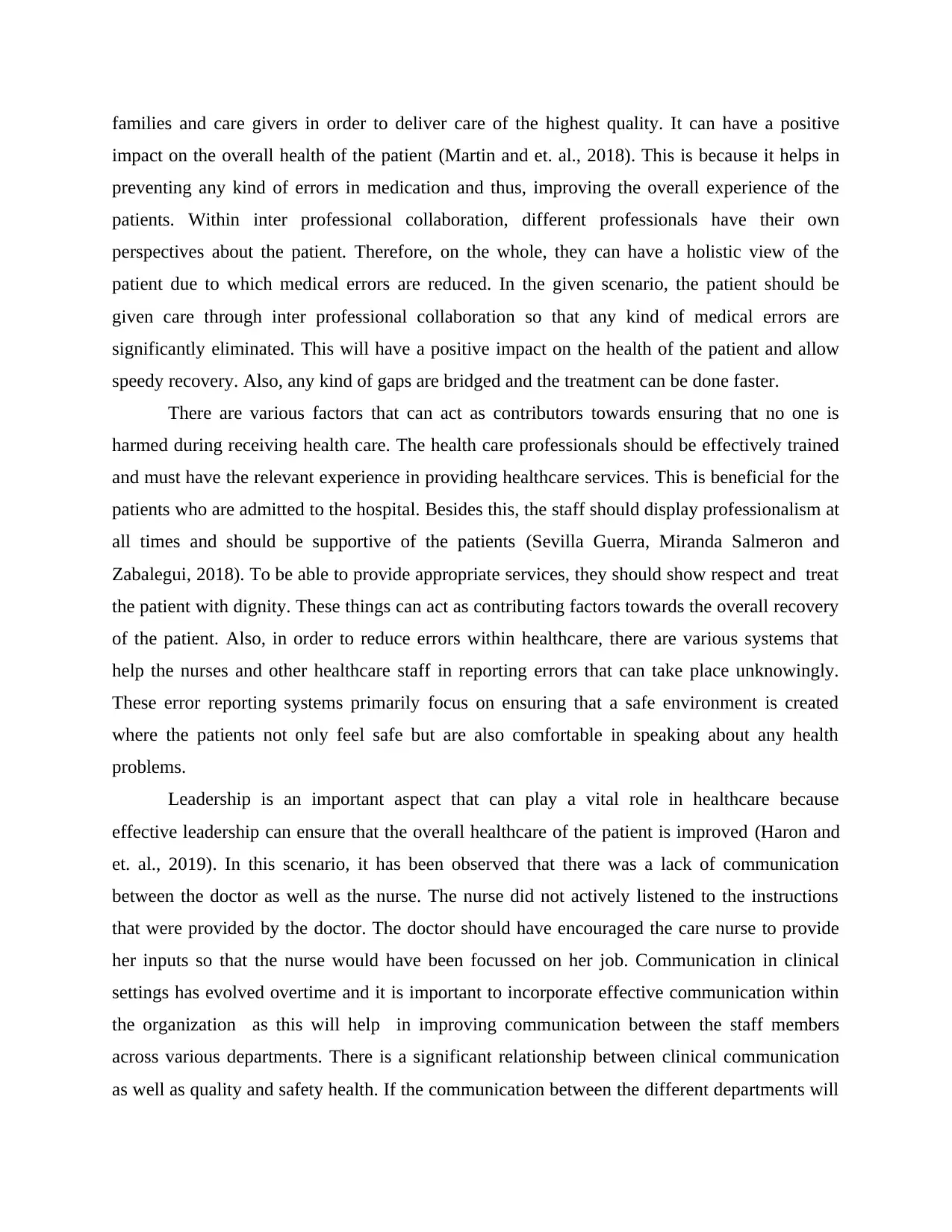
families and care givers in order to deliver care of the highest quality. It can have a positive
impact on the overall health of the patient (Martin and et. al., 2018). This is because it helps in
preventing any kind of errors in medication and thus, improving the overall experience of the
patients. Within inter professional collaboration, different professionals have their own
perspectives about the patient. Therefore, on the whole, they can have a holistic view of the
patient due to which medical errors are reduced. In the given scenario, the patient should be
given care through inter professional collaboration so that any kind of medical errors are
significantly eliminated. This will have a positive impact on the health of the patient and allow
speedy recovery. Also, any kind of gaps are bridged and the treatment can be done faster.
There are various factors that can act as contributors towards ensuring that no one is
harmed during receiving health care. The health care professionals should be effectively trained
and must have the relevant experience in providing healthcare services. This is beneficial for the
patients who are admitted to the hospital. Besides this, the staff should display professionalism at
all times and should be supportive of the patients (Sevilla Guerra, Miranda Salmeron and
Zabalegui, 2018). To be able to provide appropriate services, they should show respect and treat
the patient with dignity. These things can act as contributing factors towards the overall recovery
of the patient. Also, in order to reduce errors within healthcare, there are various systems that
help the nurses and other healthcare staff in reporting errors that can take place unknowingly.
These error reporting systems primarily focus on ensuring that a safe environment is created
where the patients not only feel safe but are also comfortable in speaking about any health
problems.
Leadership is an important aspect that can play a vital role in healthcare because
effective leadership can ensure that the overall healthcare of the patient is improved (Haron and
et. al., 2019). In this scenario, it has been observed that there was a lack of communication
between the doctor as well as the nurse. The nurse did not actively listened to the instructions
that were provided by the doctor. The doctor should have encouraged the care nurse to provide
her inputs so that the nurse would have been focussed on her job. Communication in clinical
settings has evolved overtime and it is important to incorporate effective communication within
the organization as this will help in improving communication between the staff members
across various departments. There is a significant relationship between clinical communication
as well as quality and safety health. If the communication between the different departments will
impact on the overall health of the patient (Martin and et. al., 2018). This is because it helps in
preventing any kind of errors in medication and thus, improving the overall experience of the
patients. Within inter professional collaboration, different professionals have their own
perspectives about the patient. Therefore, on the whole, they can have a holistic view of the
patient due to which medical errors are reduced. In the given scenario, the patient should be
given care through inter professional collaboration so that any kind of medical errors are
significantly eliminated. This will have a positive impact on the health of the patient and allow
speedy recovery. Also, any kind of gaps are bridged and the treatment can be done faster.
There are various factors that can act as contributors towards ensuring that no one is
harmed during receiving health care. The health care professionals should be effectively trained
and must have the relevant experience in providing healthcare services. This is beneficial for the
patients who are admitted to the hospital. Besides this, the staff should display professionalism at
all times and should be supportive of the patients (Sevilla Guerra, Miranda Salmeron and
Zabalegui, 2018). To be able to provide appropriate services, they should show respect and treat
the patient with dignity. These things can act as contributing factors towards the overall recovery
of the patient. Also, in order to reduce errors within healthcare, there are various systems that
help the nurses and other healthcare staff in reporting errors that can take place unknowingly.
These error reporting systems primarily focus on ensuring that a safe environment is created
where the patients not only feel safe but are also comfortable in speaking about any health
problems.
Leadership is an important aspect that can play a vital role in healthcare because
effective leadership can ensure that the overall healthcare of the patient is improved (Haron and
et. al., 2019). In this scenario, it has been observed that there was a lack of communication
between the doctor as well as the nurse. The nurse did not actively listened to the instructions
that were provided by the doctor. The doctor should have encouraged the care nurse to provide
her inputs so that the nurse would have been focussed on her job. Communication in clinical
settings has evolved overtime and it is important to incorporate effective communication within
the organization as this will help in improving communication between the staff members
across various departments. There is a significant relationship between clinical communication
as well as quality and safety health. If the communication between the different departments will
⊘ This is a preview!⊘
Do you want full access?
Subscribe today to unlock all pages.

Trusted by 1+ million students worldwide
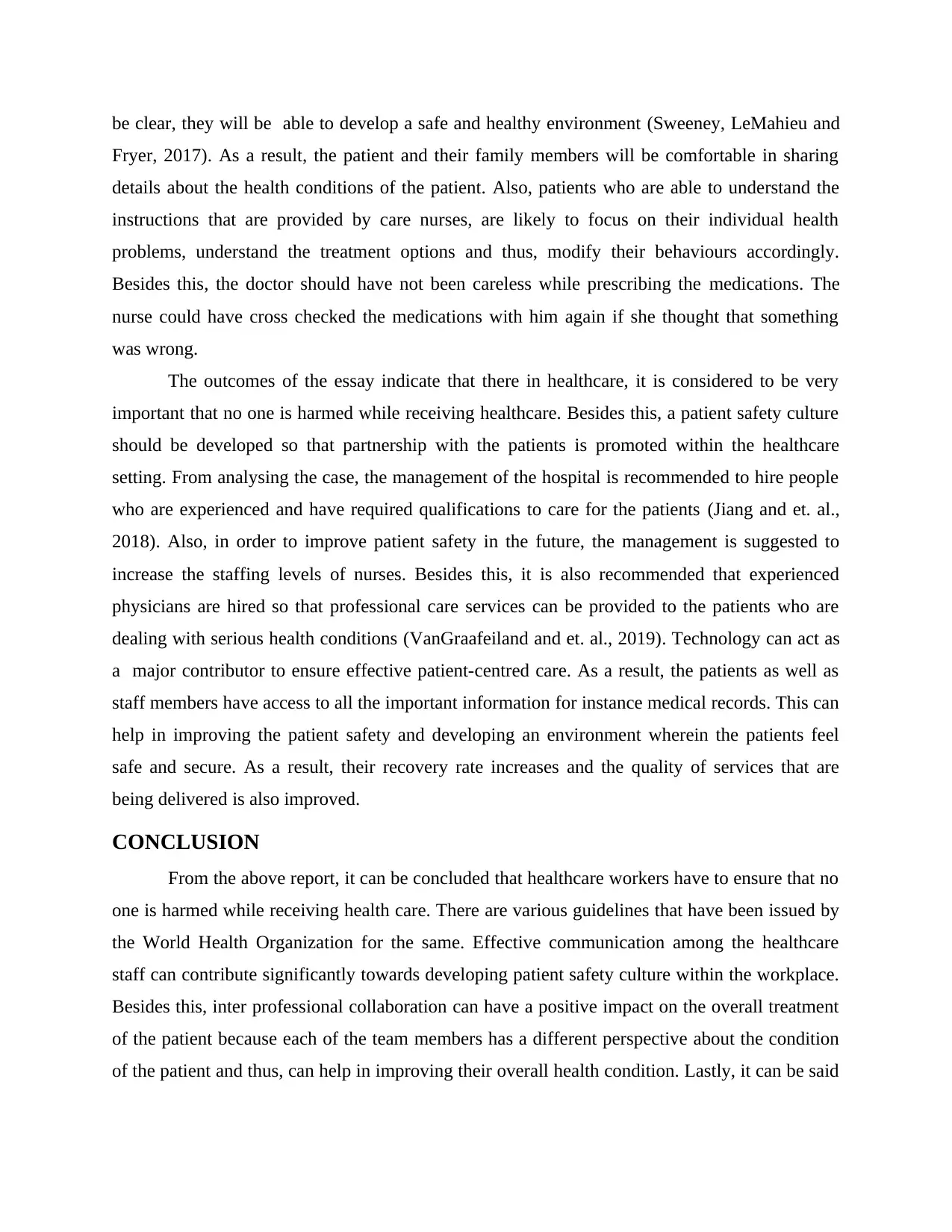
be clear, they will be able to develop a safe and healthy environment (Sweeney, LeMahieu and
Fryer, 2017). As a result, the patient and their family members will be comfortable in sharing
details about the health conditions of the patient. Also, patients who are able to understand the
instructions that are provided by care nurses, are likely to focus on their individual health
problems, understand the treatment options and thus, modify their behaviours accordingly.
Besides this, the doctor should have not been careless while prescribing the medications. The
nurse could have cross checked the medications with him again if she thought that something
was wrong.
The outcomes of the essay indicate that there in healthcare, it is considered to be very
important that no one is harmed while receiving healthcare. Besides this, a patient safety culture
should be developed so that partnership with the patients is promoted within the healthcare
setting. From analysing the case, the management of the hospital is recommended to hire people
who are experienced and have required qualifications to care for the patients (Jiang and et. al.,
2018). Also, in order to improve patient safety in the future, the management is suggested to
increase the staffing levels of nurses. Besides this, it is also recommended that experienced
physicians are hired so that professional care services can be provided to the patients who are
dealing with serious health conditions (VanGraafeiland and et. al., 2019). Technology can act as
a major contributor to ensure effective patient-centred care. As a result, the patients as well as
staff members have access to all the important information for instance medical records. This can
help in improving the patient safety and developing an environment wherein the patients feel
safe and secure. As a result, their recovery rate increases and the quality of services that are
being delivered is also improved.
CONCLUSION
From the above report, it can be concluded that healthcare workers have to ensure that no
one is harmed while receiving health care. There are various guidelines that have been issued by
the World Health Organization for the same. Effective communication among the healthcare
staff can contribute significantly towards developing patient safety culture within the workplace.
Besides this, inter professional collaboration can have a positive impact on the overall treatment
of the patient because each of the team members has a different perspective about the condition
of the patient and thus, can help in improving their overall health condition. Lastly, it can be said
Fryer, 2017). As a result, the patient and their family members will be comfortable in sharing
details about the health conditions of the patient. Also, patients who are able to understand the
instructions that are provided by care nurses, are likely to focus on their individual health
problems, understand the treatment options and thus, modify their behaviours accordingly.
Besides this, the doctor should have not been careless while prescribing the medications. The
nurse could have cross checked the medications with him again if she thought that something
was wrong.
The outcomes of the essay indicate that there in healthcare, it is considered to be very
important that no one is harmed while receiving healthcare. Besides this, a patient safety culture
should be developed so that partnership with the patients is promoted within the healthcare
setting. From analysing the case, the management of the hospital is recommended to hire people
who are experienced and have required qualifications to care for the patients (Jiang and et. al.,
2018). Also, in order to improve patient safety in the future, the management is suggested to
increase the staffing levels of nurses. Besides this, it is also recommended that experienced
physicians are hired so that professional care services can be provided to the patients who are
dealing with serious health conditions (VanGraafeiland and et. al., 2019). Technology can act as
a major contributor to ensure effective patient-centred care. As a result, the patients as well as
staff members have access to all the important information for instance medical records. This can
help in improving the patient safety and developing an environment wherein the patients feel
safe and secure. As a result, their recovery rate increases and the quality of services that are
being delivered is also improved.
CONCLUSION
From the above report, it can be concluded that healthcare workers have to ensure that no
one is harmed while receiving health care. There are various guidelines that have been issued by
the World Health Organization for the same. Effective communication among the healthcare
staff can contribute significantly towards developing patient safety culture within the workplace.
Besides this, inter professional collaboration can have a positive impact on the overall treatment
of the patient because each of the team members has a different perspective about the condition
of the patient and thus, can help in improving their overall health condition. Lastly, it can be said
Paraphrase This Document
Need a fresh take? Get an instant paraphrase of this document with our AI Paraphraser
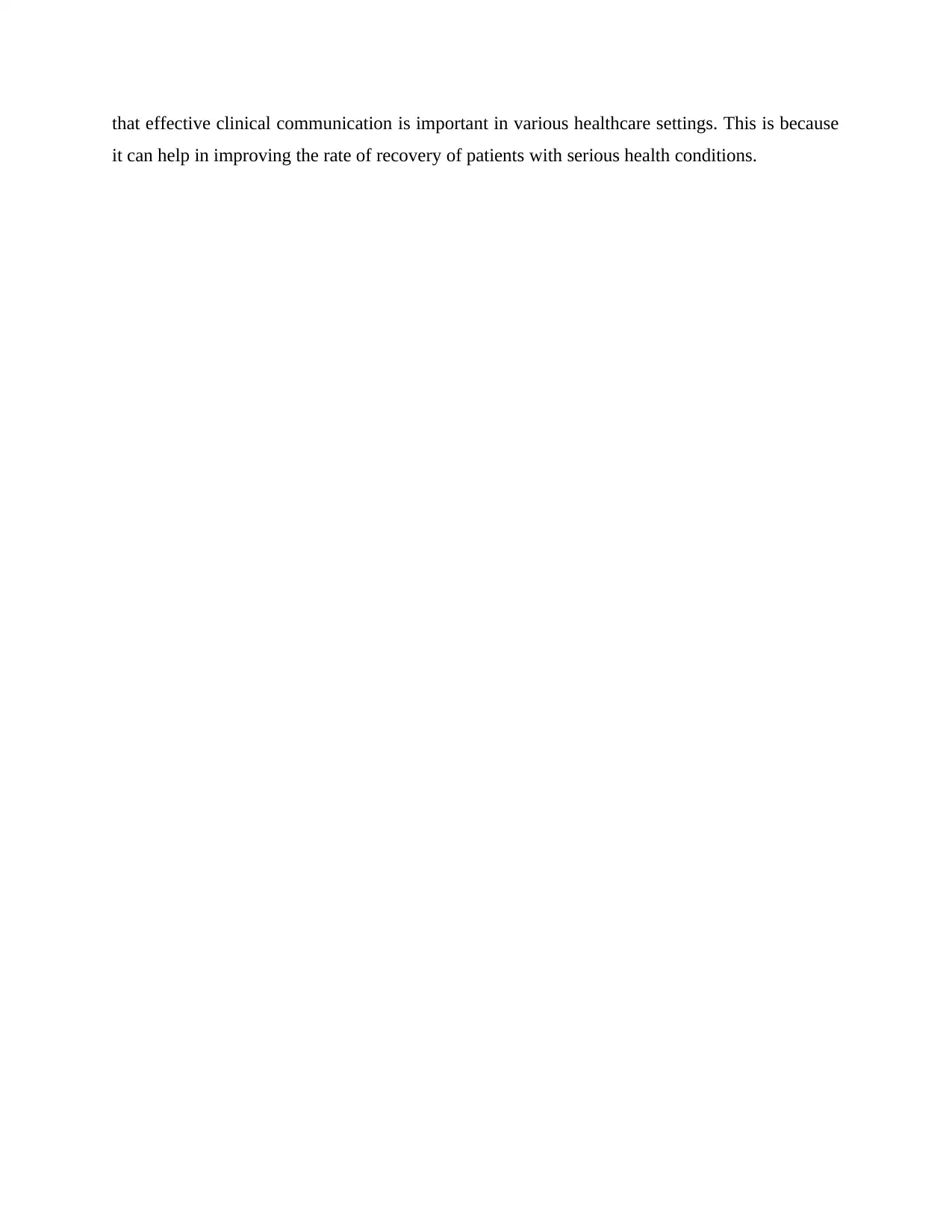
that effective clinical communication is important in various healthcare settings. This is because
it can help in improving the rate of recovery of patients with serious health conditions.
it can help in improving the rate of recovery of patients with serious health conditions.
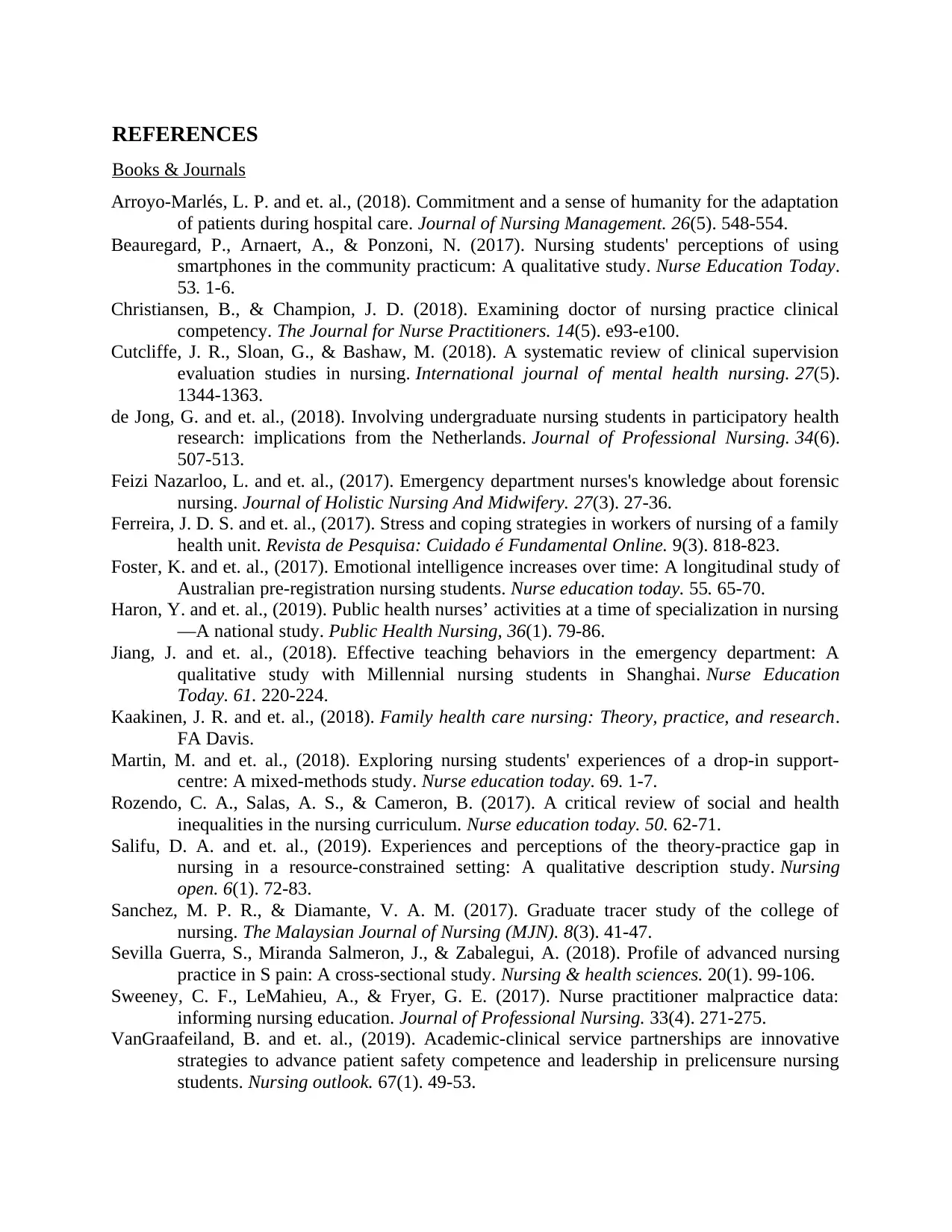
REFERENCES
Books & Journals
Arroyo‐Marlés, L. P. and et. al., (2018). Commitment and a sense of humanity for the adaptation
of patients during hospital care. Journal of Nursing Management. 26(5). 548-554.
Beauregard, P., Arnaert, A., & Ponzoni, N. (2017). Nursing students' perceptions of using
smartphones in the community practicum: A qualitative study. Nurse Education Today.
53. 1-6.
Christiansen, B., & Champion, J. D. (2018). Examining doctor of nursing practice clinical
competency. The Journal for Nurse Practitioners. 14(5). e93-e100.
Cutcliffe, J. R., Sloan, G., & Bashaw, M. (2018). A systematic review of clinical supervision
evaluation studies in nursing. International journal of mental health nursing. 27(5).
1344-1363.
de Jong, G. and et. al., (2018). Involving undergraduate nursing students in participatory health
research: implications from the Netherlands. Journal of Professional Nursing. 34(6).
507-513.
Feizi Nazarloo, L. and et. al., (2017). Emergency department nurses's knowledge about forensic
nursing. Journal of Holistic Nursing And Midwifery. 27(3). 27-36.
Ferreira, J. D. S. and et. al., (2017). Stress and coping strategies in workers of nursing of a family
health unit. Revista de Pesquisa: Cuidado é Fundamental Online. 9(3). 818-823.
Foster, K. and et. al., (2017). Emotional intelligence increases over time: A longitudinal study of
Australian pre-registration nursing students. Nurse education today. 55. 65-70.
Haron, Y. and et. al., (2019). Public health nurses’ activities at a time of specialization in nursing
—A national study. Public Health Nursing, 36(1). 79-86.
Jiang, J. and et. al., (2018). Effective teaching behaviors in the emergency department: A
qualitative study with Millennial nursing students in Shanghai. Nurse Education
Today. 61. 220-224.
Kaakinen, J. R. and et. al., (2018). Family health care nursing: Theory, practice, and research.
FA Davis.
Martin, M. and et. al., (2018). Exploring nursing students' experiences of a drop-in support-
centre: A mixed-methods study. Nurse education today. 69. 1-7.
Rozendo, C. A., Salas, A. S., & Cameron, B. (2017). A critical review of social and health
inequalities in the nursing curriculum. Nurse education today. 50. 62-71.
Salifu, D. A. and et. al., (2019). Experiences and perceptions of the theory‐practice gap in
nursing in a resource‐constrained setting: A qualitative description study. Nursing
open. 6(1). 72-83.
Sanchez, M. P. R., & Diamante, V. A. M. (2017). Graduate tracer study of the college of
nursing. The Malaysian Journal of Nursing (MJN). 8(3). 41-47.
Sevilla Guerra, S., Miranda Salmeron, J., & Zabalegui, A. (2018). Profile of advanced nursing
practice in S pain: A cross‐sectional study. Nursing & health sciences. 20(1). 99-106.
Sweeney, C. F., LeMahieu, A., & Fryer, G. E. (2017). Nurse practitioner malpractice data:
informing nursing education. Journal of Professional Nursing. 33(4). 271-275.
VanGraafeiland, B. and et. al., (2019). Academic-clinical service partnerships are innovative
strategies to advance patient safety competence and leadership in prelicensure nursing
students. Nursing outlook. 67(1). 49-53.
Books & Journals
Arroyo‐Marlés, L. P. and et. al., (2018). Commitment and a sense of humanity for the adaptation
of patients during hospital care. Journal of Nursing Management. 26(5). 548-554.
Beauregard, P., Arnaert, A., & Ponzoni, N. (2017). Nursing students' perceptions of using
smartphones in the community practicum: A qualitative study. Nurse Education Today.
53. 1-6.
Christiansen, B., & Champion, J. D. (2018). Examining doctor of nursing practice clinical
competency. The Journal for Nurse Practitioners. 14(5). e93-e100.
Cutcliffe, J. R., Sloan, G., & Bashaw, M. (2018). A systematic review of clinical supervision
evaluation studies in nursing. International journal of mental health nursing. 27(5).
1344-1363.
de Jong, G. and et. al., (2018). Involving undergraduate nursing students in participatory health
research: implications from the Netherlands. Journal of Professional Nursing. 34(6).
507-513.
Feizi Nazarloo, L. and et. al., (2017). Emergency department nurses's knowledge about forensic
nursing. Journal of Holistic Nursing And Midwifery. 27(3). 27-36.
Ferreira, J. D. S. and et. al., (2017). Stress and coping strategies in workers of nursing of a family
health unit. Revista de Pesquisa: Cuidado é Fundamental Online. 9(3). 818-823.
Foster, K. and et. al., (2017). Emotional intelligence increases over time: A longitudinal study of
Australian pre-registration nursing students. Nurse education today. 55. 65-70.
Haron, Y. and et. al., (2019). Public health nurses’ activities at a time of specialization in nursing
—A national study. Public Health Nursing, 36(1). 79-86.
Jiang, J. and et. al., (2018). Effective teaching behaviors in the emergency department: A
qualitative study with Millennial nursing students in Shanghai. Nurse Education
Today. 61. 220-224.
Kaakinen, J. R. and et. al., (2018). Family health care nursing: Theory, practice, and research.
FA Davis.
Martin, M. and et. al., (2018). Exploring nursing students' experiences of a drop-in support-
centre: A mixed-methods study. Nurse education today. 69. 1-7.
Rozendo, C. A., Salas, A. S., & Cameron, B. (2017). A critical review of social and health
inequalities in the nursing curriculum. Nurse education today. 50. 62-71.
Salifu, D. A. and et. al., (2019). Experiences and perceptions of the theory‐practice gap in
nursing in a resource‐constrained setting: A qualitative description study. Nursing
open. 6(1). 72-83.
Sanchez, M. P. R., & Diamante, V. A. M. (2017). Graduate tracer study of the college of
nursing. The Malaysian Journal of Nursing (MJN). 8(3). 41-47.
Sevilla Guerra, S., Miranda Salmeron, J., & Zabalegui, A. (2018). Profile of advanced nursing
practice in S pain: A cross‐sectional study. Nursing & health sciences. 20(1). 99-106.
Sweeney, C. F., LeMahieu, A., & Fryer, G. E. (2017). Nurse practitioner malpractice data:
informing nursing education. Journal of Professional Nursing. 33(4). 271-275.
VanGraafeiland, B. and et. al., (2019). Academic-clinical service partnerships are innovative
strategies to advance patient safety competence and leadership in prelicensure nursing
students. Nursing outlook. 67(1). 49-53.
⊘ This is a preview!⊘
Do you want full access?
Subscribe today to unlock all pages.

Trusted by 1+ million students worldwide
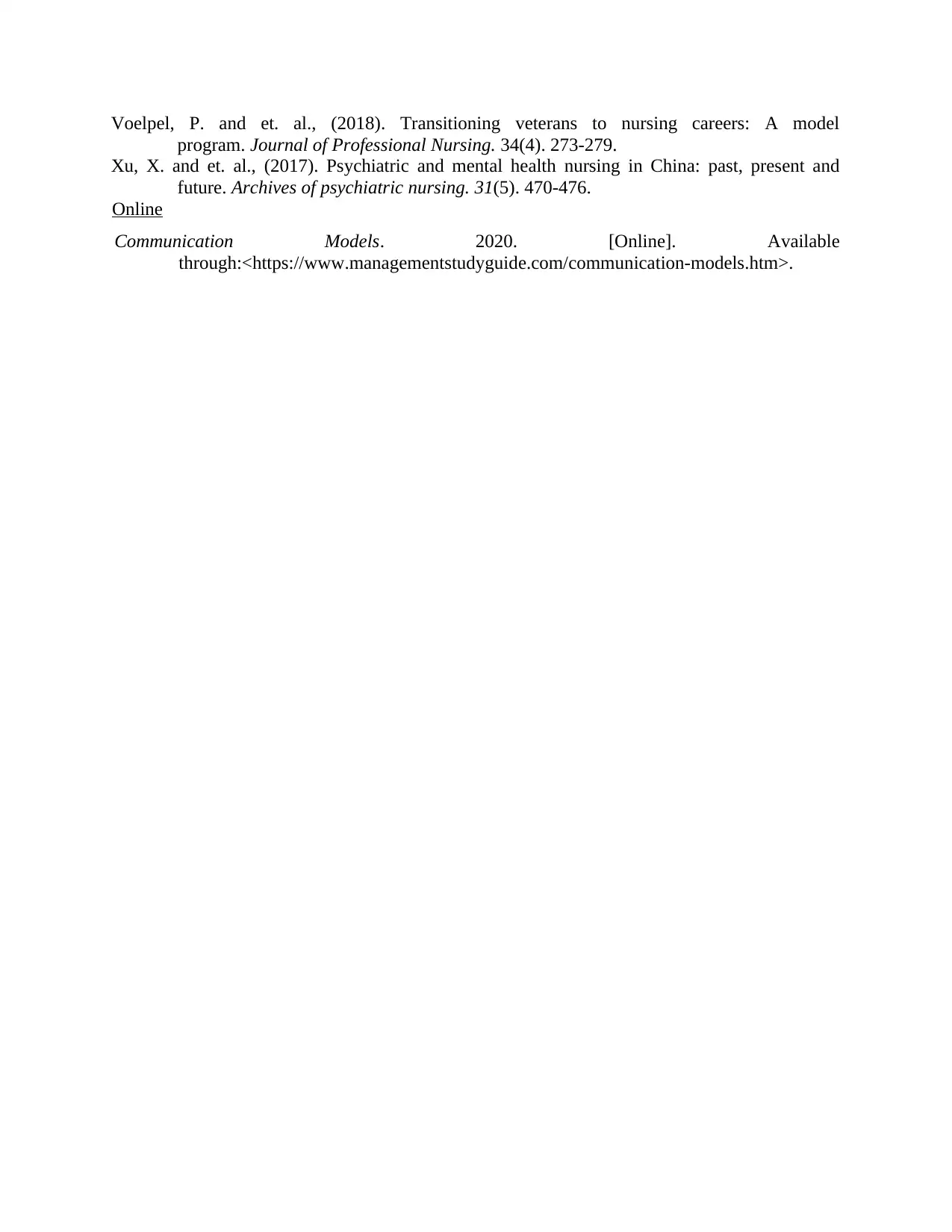
Voelpel, P. and et. al., (2018). Transitioning veterans to nursing careers: A model
program. Journal of Professional Nursing. 34(4). 273-279.
Xu, X. and et. al., (2017). Psychiatric and mental health nursing in China: past, present and
future. Archives of psychiatric nursing. 31(5). 470-476.
Online
Communication Models. 2020. [Online]. Available
through:<https://www.managementstudyguide.com/communication-models.htm>.
program. Journal of Professional Nursing. 34(4). 273-279.
Xu, X. and et. al., (2017). Psychiatric and mental health nursing in China: past, present and
future. Archives of psychiatric nursing. 31(5). 470-476.
Online
Communication Models. 2020. [Online]. Available
through:<https://www.managementstudyguide.com/communication-models.htm>.
1 out of 10
Related Documents
Your All-in-One AI-Powered Toolkit for Academic Success.
+13062052269
info@desklib.com
Available 24*7 on WhatsApp / Email
![[object Object]](/_next/static/media/star-bottom.7253800d.svg)
Unlock your academic potential
Copyright © 2020–2025 A2Z Services. All Rights Reserved. Developed and managed by ZUCOL.





